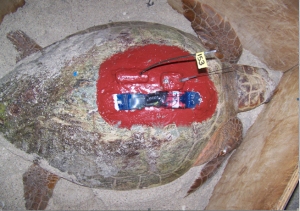Grant: 06-021R
Project Title: Acoustic Environment of Loggerhead Sea Turtles (Caretta caretta)
Project Manager: Dr. Anton Tucker
Organization: Mote Marine Laboratory (Non-Profit Organization)
Grant Amount: $30,660.00
Completion Date: 2008-11-05
Summary: The legislative agenda of the US Congress is currently considering offshore exploration for natural gas and petroleum within 9-20 miles of Florida Gulf coast, a region that overlaps with many sea turtles during the inter-nesting interval. The acoustic effects of undersea exploration and of vessel traffic are currently unknown for free-ranging sea turtles. This project will generate the first records of the acoustic environment of loggerhead sea turtles in inter-nesting habitats. Nesting females will be equipped with an acoustic bioprobe, a GPS satellite tag, and a GPS/GSM communication unit before they swim away for an inter-nesting interval. A recording tag will determine the acoustic environment experienced by turtles in the offshore environment. The GPS tag will give fine scale movement information to link with the bioacoustic data. When a turtle returns to nest, a GPS/GSM unit will allow precise location to ensure recovery of the archival data loggers. The data gleaned and refinement of methodology developed from a near shore study is a prerequisite before any studies are attempted on acoustic environments experienced by turtles in offshore realms. This project is a developmental step toward a more complete understanding of threats faced by sea turtles from boat traffic and opening the Florida near shore and offshore shelf to natural resource exploration.  Results: Post-nesting loggerhead sea turtles (Caretta caretta) on Casey Key, FL, USA were fitted with bioacoustic tags in the first study of the underwater acoustic environments encountered by turtles after leaving a nesting beach. This technology may prove beneficial in monitoring potential impacts of near shore anthropogenic noise on the natural environment of sea turtles. These tags document natural environmental noise in addition to monitoring boat interactions, trawling, dredging events and any other source of noise input to the marine environment. The bioacoustic tags were attached to female turtles after nesting using a fast-drying epoxy. These turtles were also fitted with a satellite-linked PTT and a VHF transmitter for tracking purposes. Bioacoustic tags were set to record on a fixed schedule, either 15 seconds per five minute interval or 5 seconds per 1 minute interval. Tag schedule was set to maximize battery life. The tag was recovered on the next documented emergence, utilizing satellite and VHF data to locate the turtle. Upon recovery, data was analyzed with a custom MATLAB program designed to calculate sound pressure levels over time. Using this program, it was possible to detect boat noise in addition to surfacing behavior and natural environmental noise. This study provides the first recorded data of the near shore acoustic environment of nesting loggerhead turtles in the internesting interval. This technology is a necessary first step in developing a more complete understanding of effects of seismic exploration for natural gas and petroleum in addition to the responses of turtles to boat traffic. The next generation of acoustic tags has added capabilities to record 3-D acceleration, temperature and depth to record turtle movement in relation to environmental and anthropogenic noise. This study and future studies will create a more thorough understanding of the marine acoustic environment, the presence of anthropogenic noise, and the possible impacts to sea turtles. (Authors: Kelly Martin, David Mann, and Tony D. Tucker)
Results: Post-nesting loggerhead sea turtles (Caretta caretta) on Casey Key, FL, USA were fitted with bioacoustic tags in the first study of the underwater acoustic environments encountered by turtles after leaving a nesting beach. This technology may prove beneficial in monitoring potential impacts of near shore anthropogenic noise on the natural environment of sea turtles. These tags document natural environmental noise in addition to monitoring boat interactions, trawling, dredging events and any other source of noise input to the marine environment. The bioacoustic tags were attached to female turtles after nesting using a fast-drying epoxy. These turtles were also fitted with a satellite-linked PTT and a VHF transmitter for tracking purposes. Bioacoustic tags were set to record on a fixed schedule, either 15 seconds per five minute interval or 5 seconds per 1 minute interval. Tag schedule was set to maximize battery life. The tag was recovered on the next documented emergence, utilizing satellite and VHF data to locate the turtle. Upon recovery, data was analyzed with a custom MATLAB program designed to calculate sound pressure levels over time. Using this program, it was possible to detect boat noise in addition to surfacing behavior and natural environmental noise. This study provides the first recorded data of the near shore acoustic environment of nesting loggerhead turtles in the internesting interval. This technology is a necessary first step in developing a more complete understanding of effects of seismic exploration for natural gas and petroleum in addition to the responses of turtles to boat traffic. The next generation of acoustic tags has added capabilities to record 3-D acceleration, temperature and depth to record turtle movement in relation to environmental and anthropogenic noise. This study and future studies will create a more thorough understanding of the marine acoustic environment, the presence of anthropogenic noise, and the possible impacts to sea turtles. (Authors: Kelly Martin, David Mann, and Tony D. Tucker)